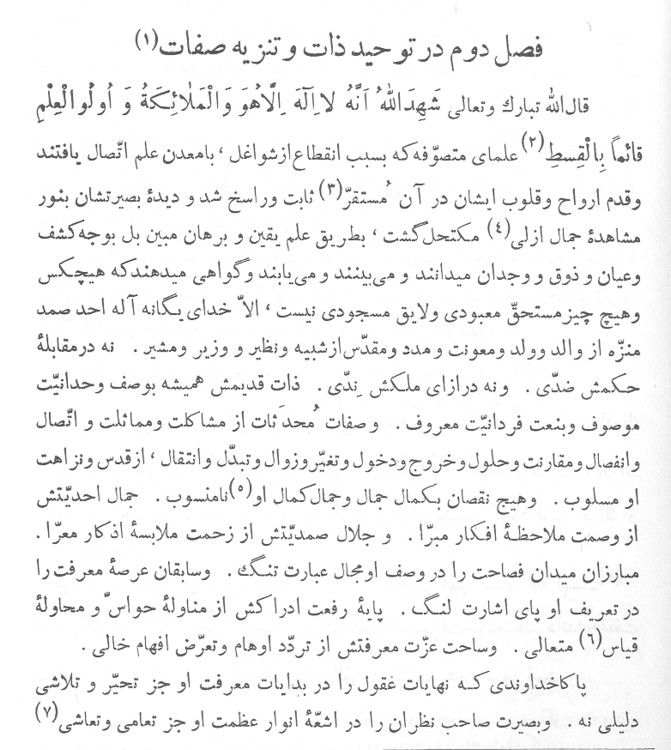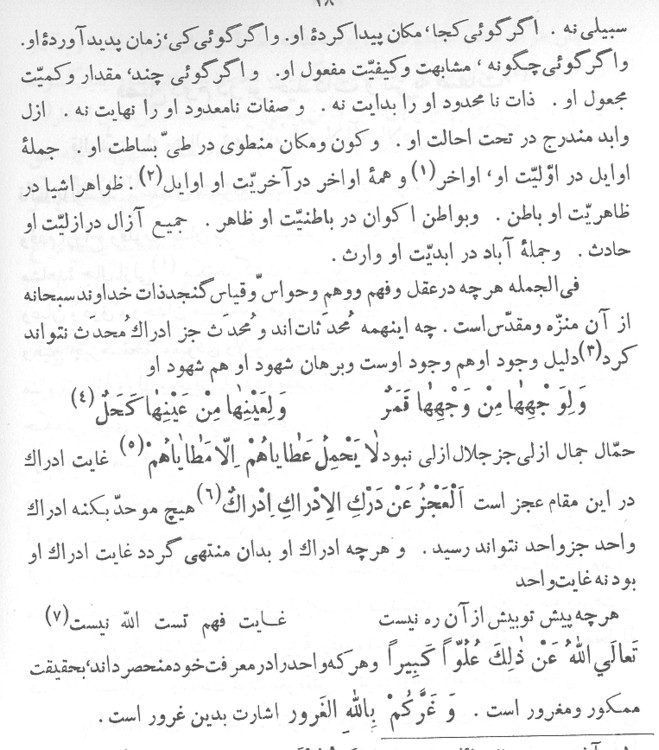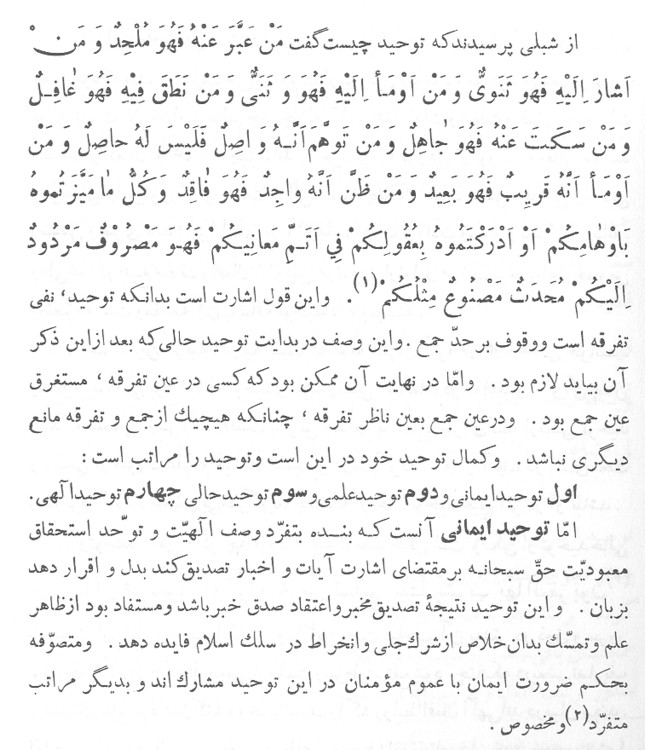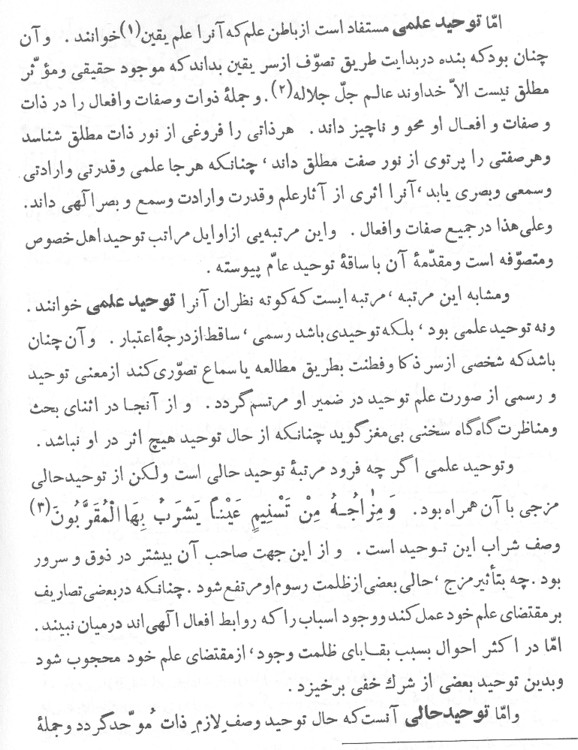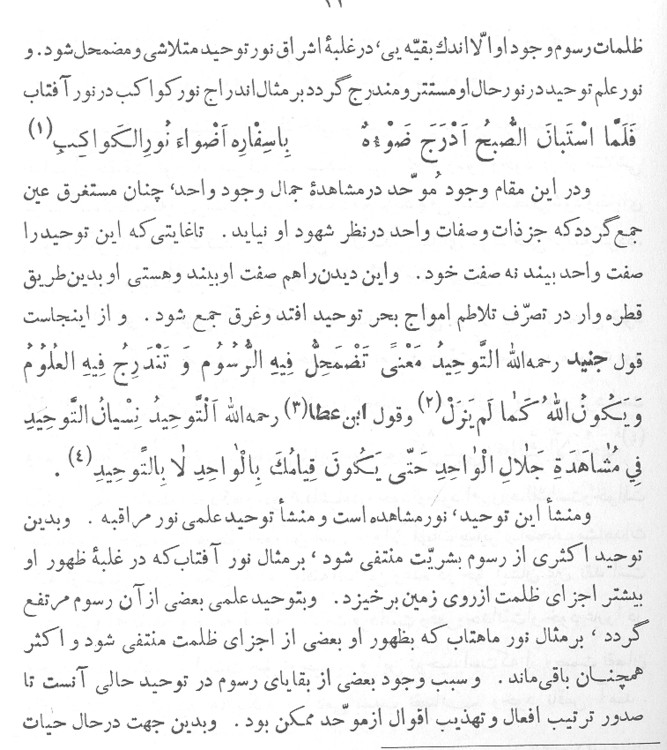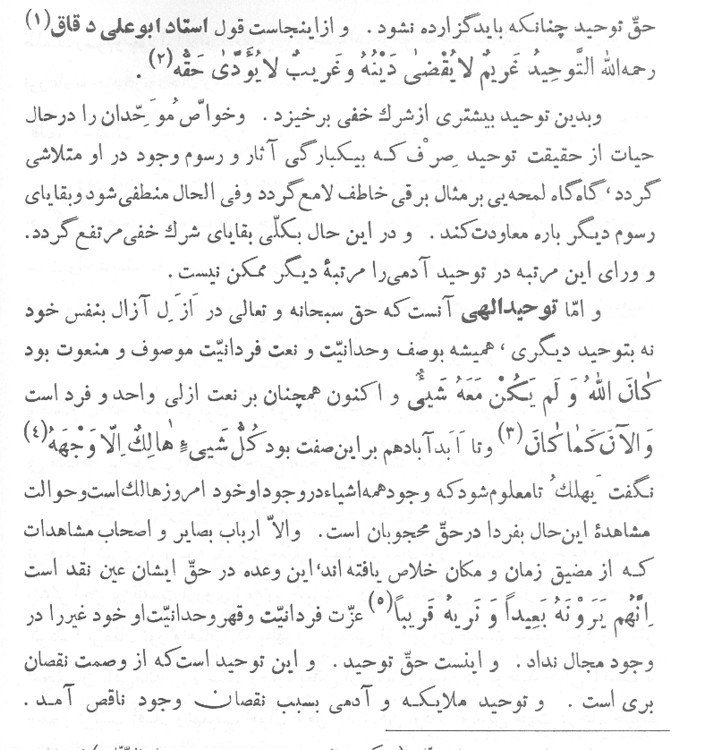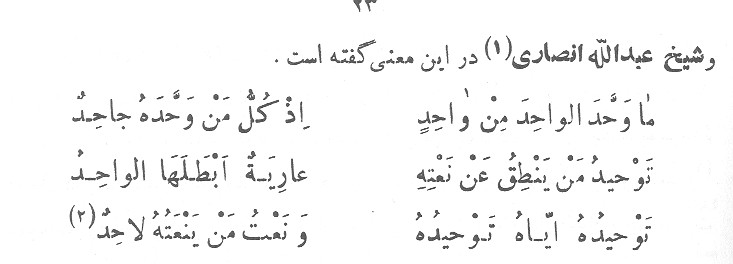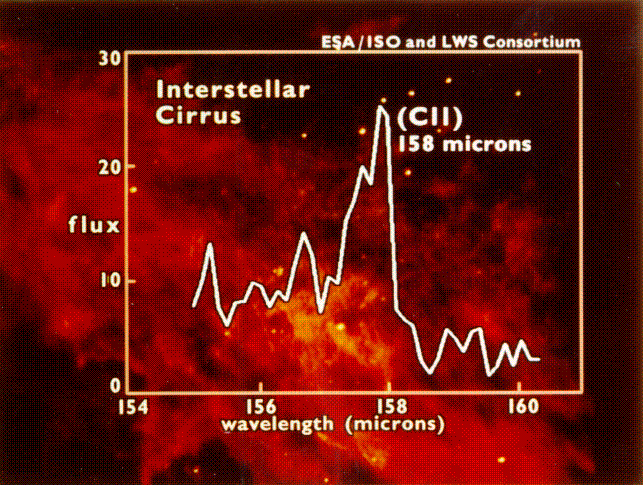
The Oneness
(Tawhid) of Essence & Purity of Sifat
(Attributes)
The Blessed and the Highness
Allah Almighty has said, Koran
[3:18]:
“There is no god but He: That is the
witness of Allah, His
angels, and those endued with knowledge, standing firm on justice.
There is no
god but He, the Exalted in Power, the Wise”
The Sufi scholars because of
their disassociation with
mundane daily affairs of living have found a route to the mines of
knowledge
wherein souls and hearts stepping at peace with constant continuance
and
resolute firmness. And the eyes of their spiritual vision wears the
effulgent
eye-shadow of resplendent beauty, that very beauty which has no cause
or
beginning (Azal), by means of knowledge of Certainty (Yaqin) and clear
reasoning (Borhaan) due to uncovering (of the secrets), (uncovering) of
the
eyes, the passion and enlightened consciousness (Wajd)
[0] they comprehend they
behold they find and finally they bear witness that truly no one and
nothing
deserves deification or worthy of prostration (Sojood).
Except the eternally unique
one God the sole deity worthy of
worship (Elah), Nonesuch Nonpareil One (Ahad), the Noble One with no
needs
while satisfying and giving for all needs and all requests (Samad),
free from
parenthood and childhood, free from employment of assistant, the holy
one
(Qoddoos) sanctified from similarities duplicates advisors and
consultants.
Nothing can withstand opposing
Its command.
Nothing likens to Its
ever-expanding dominion.
Its timelessly preexistent
ancient essence, renowned for
characteristics and attributes of Oneness. And Its Sifat (attributes)
due to
the sanctity of holiness and purity thus separated afar and away from
the
following: descriptions, shapes/forms/designs,
similarities/duplicates/parallels, connectivity & discontinuity,
companionship, intermixing, exit & entrance, change, blight,
transformation/transition/transmutation and transportation/movement.
No blemish applicable to the
paragon perfection of Its
beauty or the ideal beauty of Its perfection.
The beauty of Its Oneness
(Ahad) purified and cleansed from
the shortcomings, errors and malfunctions of comprehensions of
thoughts. The
glory and majesty of Its everlastingness (Samad) free from the labor of
immixed
remembrances and memories.
The poetic warriors marching
the battlefields of eloquence
find but scant phrases describing Its beauty. The experts in arena of
psychological cognizance and knowledge, their models and metaphors
(Isharat)
nothing but lame and limping legs.
The lofty foundation of Its
prehension [1]wafting
above the
endowment of senses and wit of reasoning and logic.
Most Pure is the Lord that the
outer-limits of the minds
bewildered and scattered while pondering even the very beginning of Its
noesis
thus (minds) remained with no further reasoning. Because of the
splendor of
the
lustrous rays of Its Mightiness, the eyes of the learned men blinded
and lost
they are within the darkness of the night with no further to travel.
When you ask where? That place
is already found by It. [2]
When you ask when? That time
interval is already brought
about by It.
When you ask what? That action
is already the active doing
of It.
When you ask how much? That
quality and quantity is already
bestowed and measured by It.
Its unbound Essence has no
beginning. And Its unnumbered
Sifat (attributes) no limits. ‘Azal’: the existence without beginning
or cause
and ‘Abad’: the eternity with no end, are both under the control and
doing of
Its affairs. The time-space unrolling alongside Its ever-spreading
ever-expansive
extensiveness.
The collective of all
beginnings, the last in comparison to
Its primordial attribute (Awwal), and the collective of all ends just
the mere
beginnings in comparison to Its ultimate finality (Akhir).
The presence and manifest of
all objects deeply (hidden)
within Its presence and manifest (Zahir). The inner mechanisms and
processes of
the cosmos plainly manifest and surface to Its inner hidden essence
(Baaten).
[3]
The entire non-causalities and
unknown origins that face Its
Azal (being without reason, cause or beginning) are mere consequences
of events
and causes. And all eternities within Its eternality are merely Its
inheritance
(Warith).
In summary whatsoever may fit
within the mind, cognition,
imagination, senses and logic, the praiseworthy holy Lord is sanctified
and
pure—afar and away—from It. Since all things in this world are temporal
and
denovo consequences therefore our temporal minds prehends no other than
short-lived immediate past or obvious consequences. It is the causality
and
reason for Its own existence and the reason for Its existence is Its
own
manifest:
And Its
face is the moon reflecting the sun of Its own face
And Its
eye adorned by the eye-shadow of Its own eye [4]
The transport of Its
non-causal (Azali) beauty nothing but
Its non-causal (Azali) majesty and might, “their
merchandize must be carried
except by their own camels”. No matter how much to stretch
the cognition there
is no way to comprehend this, “Failure to
comprehend is a form of
prehension”[5]. No single individual can ever reach the depth of
prehension of
the Nonpareil One (Wahed) except the One and Nonesuch Itself. And
whomever
(fooled) by the thinking that he has reached some comprehension of It,
indeed merely
reached the
boundaries of his own mind [6] and did not reach
anyplace close to It
wheresoever:
No routes
towards whatever is with You
These all
limits of prehension and not the Lord
(By Sanaa-ee)
Allah Almighty the Most High
(A’laa) resides above this
great (human) arrogance and whomever thinking the Nonpareil One is
captured
within (his mind) truly is fooled and deceived. And “And the
Deceiver deceived
you in respect of Allah“,
Koran [57:14], is a clear hint towards this
deception.
Shebly was asked, “What is
Tawhid (Oneness)?” He replied:
“Whoever
phrases words about It is a disbeliever, whoever
makes a metaphor about It is a polytheistic and whoever claims
uncovering of a
secret about It is an idolater, whoever talks about It is ignorant,
whoever is
silent about It is imbecile, whoever imagines It gains nothing, whoever
points
at It near indeed is afar, whoever claims finding It has already lost
It.
Whatever is imagined or thought by you are temporal meanings
manufactured by
yourself. (and have nothing to do with It)” [7]
This statement points to the
fact that Tawhid (Oneness) is
both invalidation of disunion and observing the limits of union [8]. This is
the characteristic and disposition of the human state in the beginning
of the
Tawhid (Oneness).
However approaching the
extremes of Tawhid (Oneness), a
person viewed by the eyes (of others) is in disunion but in essence in
union
(with the Beloved). Indeed neither union nor the disunion (viewed by
the
physical eyes) discriminate against each other (they coexist), hence
the
perfection of the Tawhid (Oneness).
Tawhid has four ranks:
- Oneness due to Faith
- Oneness due to Knowledge
- Oneness due to Propensity
- Oneness due to Divinity
“Oneness due to Faith” is when
the slave because of
uniqueness of divine attributes and exclusivity of the deification of
the
praiseworthy Lord which have come to his attention by means of
revelations and
other such narrations, believes in Oneness within his heart and upon
his
tongue. This Tawhid (Oneness) is the result of verification and
validation of
the narrations and narrators (Prophets, messengers, sages…) obtained by
the
surface-knowledge and prehending the Oneness shall polish to a terrific
shine—away with the rust of idolatry—which benefits the individual on
the
path/voyage of Islam. The Sufism obliged by the requirements of faith
share
this form of Tawhid (Oneness) with most believers, but on the other
forms
(items 2-3) differ and is unique in its approach.
“Oneness due to Knowledge”
comes from the innate inner
knowledge that is called the Knowledge of Certainty (Yaqin). This is
when the
slave knows from the beginning of the path of Sufism that there is no
true
absolute and potent existence other than the glorious Lord of the
universe. The
ensemble of all (other) essences attributes and actions belittled and
ethereal
within Its essence and attributes and actions. Each essence is merely
the flash
of a ray from Its absolute essence, each attribute a shaft of light
from Its
absolute attribute. In other words anywhere some knowledge, some power,
some
deliberate will, hearing and vision found, he attributes these as
traces from
divine knowledge, power, deliberate will, hearing and vision, and the
same for
all actions and attributes. This is an early rank of Tawhid (Oneness)
specialized for Sufism though an offshoot from the general branch of
Tawhid
believed by the general public.
There is a fake version of
this rank, which the dimwit calls
with the same name. Indeed it is not Tawhid (Oneness) due to Knowledge
but
better be called “Formal Tawhid”, which has almost no credibility. The
person
by means of intelligence or studying or attending lecturs imagines some
concepts about Tawhid within. And from time to time in discussions or
gatherings utters hollow expressions of Tawhid (Oneness) which none of
it found
in his nature and inclination.
Although “Tawhid (Oneness) due
to Knowledge” is a lower
notch of the “Tawhid due to Propensity”, however it may have some
mixture of
the latter. And this is the description of this Tawhid, “With it will be
(given) a mixture of Tasnim: A spring, from (the waters) whereof drink
those
Nearest to Allah.”
Koran [83:27-28]. Thus the owner of this Tawhid is filled
with passion and happiness, because tasting this wine mixture impacts
him by
shedding some of his dark customs and habits. However, he may act upon
this
knowledge and fail to see the divine interventions, instruments and
causalities
(give himself or his knowledge credit instead). But in most cases
underneath
the dark shade of his own existence and knowledge he may be veiled
(concealed from
God) thus from this some minor form of polytheism (Shirk) may arise.
“Tawhid (Oneness) due to
Propensity” is when Oneness becomes
a must for propensity/nature/inclination of the Mowah-hid (person in
the state
of Tawhid) and much of the darkness of customs/habits of his
existence—except a
little—succumbs to the terrific luminosity of Tawhid (Oneness),
shattered and
dissolved. And the light of (human) knowledge of Oneness fades within
the light
of his propensity/nature like the light of stars vanishes within the
light of
the sun.
In this state of being,
Mowah-hid (the person in the state
of Tawhid) staring upon the beauty of the Nonpareil Nonesuch One shall
drown
and dissolve/immix with such intensity that nothing other than the
essence and
attributes of the Wahid (Unique One God) perceptible for him. Until
pioneers
such extreme boundaries, where he sees this Tawhid ‘solely in and of
the
Nonpareil One (Wahid)’ and not due to anything of his Self’s
attributes. And
even this act of viewing he attributes to Its attributes, his existence
is a
mere droplet fallen into the tumultuous ocean of Tawhid (Oneness),
drowned into
a vast reunion!
Because of this Jonaid (may
rest within Allah’s mercy) said,
“The
meaning of Tawhid (Oneness) is when the customs/habits and all
knowledge
dissolves and disappears and persists Allah as It was and is (and will
be)”.
And Ibn Ataa said, “Tawhid
(Oneness) is when Tawhid is forgotten because of
perceptions of Allah’s majestic manifest until the slave subsists
entirely upon
the Nonpareil Nonesuch One and not upon the knowledge about Its Oneness
(Tawhid)”.
The origin of this Tawhid
(Oneness due to Propensity) is the
light of perception and origin of the “Oneness due to Knowledge” is the
light
of intimacy and closeness (to Beloved). By means of this Tawhid
(Oneness due to
Propensity) much of one’s humanity is pushed away like the sunlight
wipes out
most of the darkness upon the earth. But the light of the “Tawhid
(Oneness) due
to Knowledge” is likened to the light of the moon illuminating the
earth where
some of the darkness is wiped off but mostly remains unlit. What
remains of the
Mowah-hid during the “Tawhid (Oneness) due to Propensity” is the bare
necessities of actions and attributes required for his minimalist
physical
existence.
In conclusion, during the life
of this world the true Tawhid
is not given the just attention and devotion. Because of this
observation Abu
Ali Daq-qaq said, “Tawhid
(Oneness)
asked for loans and declined, a stranger not given full
rights/citizenship in
any land”.
Therefore from this Tawhid
(Oneness) shall always arise a
minor possibility of polytheism (Shirk). Although within the Mowah-hid
(person
in the state of Tawhid) shattered are the customs and habits, somehow
sometimes
a sudden flash of customs and habits may lid his life (lead away from
Tawhid).
But beyond this rank of “Tawhid (Oneness) due to Propensity” not other
ranks
available to human beings.
However the “Tawhid (Oneness)
due to Divinity” is when Allah
bears the Azal (existence without cause or reason to be or beginning)
for
Itself not subsisting upon any other creature’s Tawhid, maintaining the
attribute of Oneness and Nonesuch, “Indeed it was Allah and none else”.
At
present such Azali attribute continuing everlastingly “It is as It was” and
eternally for all eternities shall be as such, “Everything
(that exists) will
perish (Haaleko) except His own Face” (Koran [28:88]) but It did not
say “It
will destroy (yohleko)”
so it will be known that the existence of all objects
within Its own Being this very moment are subject to future and
imminent
destruction (Haaleko), thus this observation transmitted from today to
tomorrow
in order for veiled subjects (Mankind) to have a fair respite to
observe(potential for prehension). With the exception of masters of
visions and
companions of perception who have been relieved from the constrained of
time-space, whom this promise (of impending destruction) is a precious
treasure: “They see the
(Day) indeed as a far-off (event), But We see it
(quite) near.” (Koran
[70:7-8]), the mightiness of Nonpareil and subjugation of
Oneness other than to Itself forbade for others.
This is how to do justice for
Tawhid (Oneness) and this
Tawhid is pure and cleansed from all shortcomings, problems, errors and
malfunctions. Therefore the Tawhid by Angels and Mankind, because of
the
shortcomings of their beings, suffers from much problems and thus
imperfect.
And finally Sheikh Abdollah Al-Ansari about this concept said:
No one
ever did justice for Oneness
Because
every attempt subject to negation or rejection
The one
boldly lecturing about Oneness
Like a
trade canceled by the Nonpareil One
True
Oneness solely by the Nonesuch One
Disbelief
and blasphemy any other narration
End.
Background: The spectrum of
the light from the outer space
shows that the atoms and molecules have identical structure to the
compounds on
this earth!? Given the vastness of the time-space continuum why that
has to the
case? Why the carbon atoms should have the same structures billions of
light years
away? This cosmological observation is a prehension for Tawhid
(Oneness). Picture: Detection of carbon II in interstellar cirrus.
Infrared spectral studies have shown that organic molecules are
prevalent in many regions of the Universe.
[0] ‘Wajd’
is an Arabic word and a Sufi terminology for
inner consciousness when it goes through EXPERIENCES of uncovering
secrets and
hidden findings (prehensions see [1]) about the Beloved. Closest in
English is
enlightenment but in Sufism the word encompasses much. ‘Wajd’ either is
followed by jubilee or sorrow. More on this word in a later chapter
specially
dedicated for its definition INSHALLAH.
[1]
What is
Prehension? I borrowed this word from “Process and Reality” by Alfred
North
Whitehead who developed a philosophy similar to the Schrodinger’s
Quantum
mechanics. I believe Whitehead’s languages is more suitable for Sufi
translations:
- The word "prehension" is created by
dropping the first syllable from "apprehension." Prehension is a part
or aspect of the more or less complex whole which is an act of
awareness. It is the element of pure givenness in this act; experience
as the having of an object. An experience for Whitehead is a unitary
event or process termed an "actual entity" or "occasion [of
experience]." Every concrete thing which is given to or prehended by an
entity is a prior event or actual entity, or a group of such entities.
Contemporary events are not, strictly speaking, prehended, nor are
occasions subsequent to the act of prehending. Thus memory and
perception are alike in that the object of both is in the past. This
assimilation of perception to memory is a highly original element in
the doctrine.
- In his An Interpretation of
Whitehead's Metaphysics, p. 12, William A. Christian writes: A prehension
is an operation in which an actual entity "grasps" some other entity
(actual or nonfactual) and makes that entity an object of its
experience. . . . A prehension is a "concrete fact of relatedness." It
has a subject (the prehending actual entity), an object
or datum that is prehended , and a subjective form. The
subjective form of a prehension is the particular manner in which that
subject prehends that object. Subjective forms are forms of emotion,
consciousness, purpose, etc. A prehension need not be
conscious--indeed, most prehensions are not.
- Peter Farleigh, in his "Whitehead's Even
More Dangerous Idea", says: Consider the act of perception. It
is by perception, and this involves cognition, intentionality and
affective tone, that we take account of our environment. I look at a
pencil in front of me, for example. I have an immediate sense of its
overall look-its shape, its length, its color. The pencil is set
against a background of my desk and other things in my field of vision,
but not things I am at that moment acutely aware of. Also I am only
vaguely aware of my body and its relation to the desk and pen. In
seeing the pencil, too, whole streams of associative memories are
stirred. All of these perceptions and memories are gathered together
into the unity, which is this single percipient event-a 'specious
present'. The focal point or center of this event being my body. The
pencil and the background, as well as the memories, are all internal
constituents of my experience, and are therefore causally efficacious
of that experiential event. They are said to be internally related to
this event. Those objects at that moment are unaffected by my act of
perception and so are said to be externally related to the event. The
act of perception then, establishes the causal relation of a subject to
the external world at that moment. Perception and memory recall for
Whitehead are high level instances of a more general concept, which he
calls prehension. Most simply, for a subject to prehend an object, it
is to experience it, perceive it, feel it, or 'take it into account,'
though not necessarily in a conscious or reflective way. An object can
be a physical object, like a pencil, or a conceptual object like a
memory. Prehension is also a feature at lower levels of nature. Single
cells 'feel' or take account of their environment (which is often other
cells). Within a series of sub-atomic events, each event prehends its
antecedent event, and is almost entirely determined by it.
[2] When
you say, “Where is the coffee shop?” you prehend
the concept of
a building filled with customers drinking coffee but this prehension’s
appropriation is delivered from a space unseen to your eyes, seen and
created
by the Creator. The very fact that your mind is able to comprehend and
prehend
the concept of space and a question about its address requires a
preexistent
space wherein your mind prehends the concepts and data from. In the
consequent
questions Kashani asked the same applied to time and actions and
measurements…
[3] When
we see the objects around us, their manifest presence drowned
within the presence of Its manifest i.e. Its manifest is so
overwhelming and
obvious that no eyes can see it! And what we see lost and drowned
within Its
presence. On the other hand, the hard to see inner workings of objects
are
indeed obviously present and manifest upon the perimeters of Its deep
hidden
essence.
[4]
Eye-shadow, which is the Arabic word ‘Kohol’ or ‘kahal’, is a Sufi
term used as something the Beloved adds to eyes, for them, to see.
Without this
eye-shadow one may see all things but never be able to see It.
[5] In
most cases failure to understand is the end of it all, but in
Sufism it is a peculiar form of prehension i.e. though the mind failed
to grasp
some meaning still the human being as a whole managed to grasp/prehend
something of surprisingly immense value. A rare experience, which a
good Sufi
writer manages to help the reader fail the same manner but do prehend
the same
experience.
[6] The
person who says, “I do not believe in God” and the person who
says, “I believe in God” both roaming the outer-limits of their minds.
The
former prehends that there is no way any form and definition of God
possible
within the human cognitive faculties, the latter prehends facing a
sublime
existence beyond doubt. Both
experience the same but prehend and describe
differently. Both
prehensions are in some form of relations i.e. tangled,
thus all the religious problems. Their prehensions cause them to face
each
other, converse with each other and possibly oppose each other.
[7] This
saying partly or in whole is attributed to Imam Ali May Allah Be
Pleased With Him.
[8] ‘Union’ to
mean to rejoin with the Beloved Creator
and ‘Disunion’ means this life where we are separated from the Beloved.
© 2003-2002,
Dara Shayda
